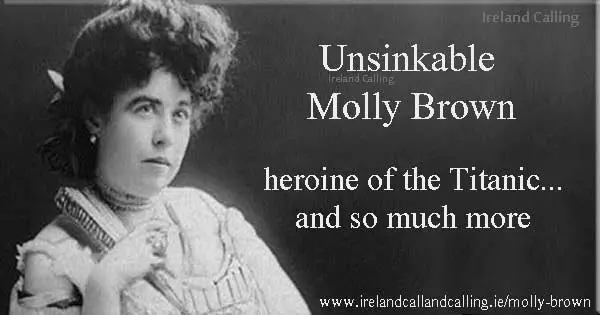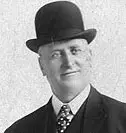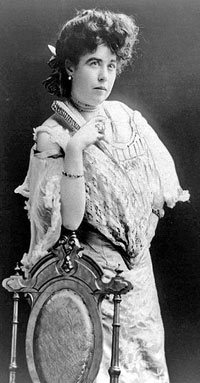Molly Brown is a famous Irish-American woman of the early 20th century, most notably as one of the surviving passengers on the ill-fated ship, the Titanic.

She was labelled ‘the Unsinkable Molly Brown’ by the media after the disaster, although throughout her life she was always known as Maggie. She is famous for trying to persuade her fellow passengers on board Lifeboat Number 6 to return to the sinking ship to rescue any survivors from the freezing water.
However, she was overruled by the ship’s commanding officer, Quartermaster Robert Hichens, who feared the lifeboat would be sunk by the desperate rush of people.
Humble beginnings
Brown was born Margaret Toibin in Hannibal, Missouri in 1867, the daughter of Irish immigrants John Toibin and Joanna Collins.
She moved to Leadville in Colorado when she was 18 and found work in department store. She met James Joseph Brown, known as JJ, and fell in love. She was unsure whether or not to marry JJ, because her plan had always been to marry a rich man who could take care of herself and her elderly father. However, she decided to marry Brown as she loved him. She spoke about her dilemma years later:
“I wanted a rich man, but I loved Jim Brown. I thought about how I wanted comfort for my father. Jim was as poor as we were, and had no better chance in life. I struggled hard with myself in those days. Finally, I decided that I’d be better off with a poor man whom I loved than with a wealthy one whose money had attracted me. So I married Jim Brown.”
Jim and Molly were married in Leadville and went on to have two children, Larry and Catherine.
Marriage break-up after 23 years
Their fortunes took a turn for the better when Jim was instrumental in a major breakthrough for his mining company. His employers rewarded him with 12,500 shares in the company and a seat on the board. The Browns were now financially secure beyond their wildest dreams. Molly used this freedom to work in a soup kitchen to help support the miner’s families.

The Browns moved to Denver in 1894 and became part of the city’s vibrant upper class society. Molly took advantage of her new-found status as a socialite. She used her influence to co-found the Denver branch of the Alliance Française, an organisation that promoted French language and culture.
“I wanted a rich man, but I loved Jim Brown. I decided that I’d be better off with a poor man whom I loved than with a wealthy one whose money had attracted me. So I married Jim Brown.” Molly Brown
In 1909, Molly and Jim agreed to separate after 23 years of marriage. The two had grown apart and the separation was amicable. Jim continued to pay Molly an allowance to enable her to spend her time working for worthy causes.
Brown was one of the socialites that helped to raise money for the Cathedral of the Immaculate Conception in Denver in 1911 and also St Joseph’s Hospital. She then assisted Judge Lindsey in establishing a Juvenile’s Court, so that wayward children could be helped and guided back onto the straight and narrow.
Judge Lindsey was also helped by Brown in his campaign to completely abolish child labour.
The ‘Unsinkable Molly Brown’

Brown was in France in 1912, and was one of the first class passengers to board the ‘unsinkable’ ship, the Titanic on its maiden voyage. She boarded on 10th April 1912 at Cherbourg. Four days later the ship collided with an iceberg in the middle of the Atlantic Ocean, and began to sink. As the news spread, the ship descended into chaos as passengers and crew desperately tried to get on board a lifeboat. Brown was one of the people that tried to bring order to the panic, and helped people board the lifeboats. She eventually boarded Lifeboat Number 6 herself.
As the lifeboat was paddled away, Brown watched as the near-900 foot Titanic finally submerged into the freezing Atlantic Ocean. She wanted to return to the site, hoping that the lifeboat would be able to save any survivors left floating in the water. But she was shouted down by the boat’s commanding officer Quartermaster Robert Hichens, who was afraid the desperate survivors would pull his boat under.
This is a particularly emotional scene in the 1997 blockbuster film of the disaster, Titanic, starring Leonardo DiCaprio and Kate Winslett. Brown, played by Kathy Bates, is shown trying to persuade her fellow passengers to return to save any survivors only to be met with silence, and Hichens shouts at her to shut up. Brown looks dismayed and heartbroken as she appeals to her fellow passengers: “I don’t understand a one of you, what’s the matter with you? It’s your men out there! There’s plenty of room for more!” It is not known if Brown actually used this phrase herself, but is more likely that it was added to the scene by the producers of the film.
‘Befuddled’ by title ‘Heroine of the Titanic’
When Brown returned to America she was labelled a heroine. She was overwhelmed by the media attention and clamour that surrounded her, believing that she only did what anyone should have done. She wrote a letter to her daughter about her experience:
“After being brined, salted, and pickled in mid ocean I am now high and dry … I have had flowers, letters, telegrams-people until I am befuddled. They are petitioning Congress to give me a medal… If I must call a specialist to examine my head it is due to the title of Heroine of the Titanic.”
After the initial uproar died down, Brown continued to use her profile to campaign for women’s rights and other worthy causes. Brown wanted to enter into politics to have more influence on social matters and ran for Senate in 1914. However, she had to abandon her campaign after the outbreak of the First World War.
Instead she travelled to France to set up a relief station for wounded soldiers. She was awarded the French Legion of Honour for her work.
Brown’s husband died in 1922. Although they were separated, they had always remained on good terms. Brown made a statement to the newspapers, saying: “I’ve never met a finer, bigger, more worthwhile man than J.J. Brown.”
She inherited a portion of his estate with the rest being split between the couple’s two children.
Brown died herself ten years later of a brain tumour. She was buried in the plot next to her husband in the Cemetery of the Holy Rood in Westbury, New York.
More history articles
The Neolithics – first people to leave their mark on Ireland